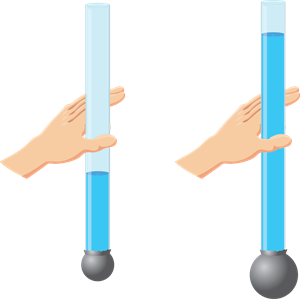
PUMPA - SMART LEARNING
எங்கள் ஆசிரியர்களுடன் 1-ஆன்-1 ஆலோசனை நேரத்தைப் பெறுங்கள். டாப்பர் ஆவதற்கு நாங்கள் பயிற்சி அளிப்போம்
Book Free DemoThe pressure exerted by a liquid at a particular point is determined by,
- Depth
- Density of the liquid and
- Acceleration due to gravity
Variation of pressure by depth
- Take two glass tubes.
- The base of the tube is fitted with a rubber balloon.
- When water is poured into the tube, the balloon starts to bulge.
The reason for this is due to the pressure that acts on the walls of the balloon. When we pour more water, the balloon bulges. This indicates that the pressure varies with height. The more the height of the liquid more will be the pressure.

Variation of pressure
Liquids exert equal pressure at the same depth. To understand this, let us consider an example. Take a water bottle, and make a hole at equal depth from the top of the bottle. Fill the bottle with water and note down the pressure. All the liquids exert the same pressure as shown in the below figure.

Pressure at same depth
If the hole is made at different depths, the pressure will vary, resulting in unequal water flow.

Unequal flow of water
In the above figure, the flow of water is uneven. It shows the pressure depends on the height. The pressure will be more at the depth and less at the top.
Variation of pressure by density:
Let us understand this by looking at the following example,
- Take two different liquids of different densities to the same level in plastic containers. Consider oil in one container and water in other.
- Make holes in the two containers at the same level.

Flow of water and cooking oil
What do you notice?
It can be seen that water is flowing out with more pressure than oil. This indicates that pressure depends on the density of the liquid.